Gay-themed books in Singapore
Five new gay-themed books for further reading.
I Will Survive by Leow Yangfa
Nearly 300 pages worth of personal gay encounters and coming out stories that will not only move you, but jolt you out of your mundane existence.
The Invisible Manuscript by Alfian Sa’at
If you think his political commentaries were sharp, wait till you get a load of his poems. Sa’at reveals all with this set of quietly devastating paeans to transient gay love, culled from his current and previous relationships.
Scattered Vertebrae by Jerrold Yam
Yam’s “coming out poems” densely trace the uncertainties of a gay childhood and all its insecurities—the perfect place to start for the uninitiated.
Straws, Sticks, Bricks by Cyril Wong
Wong’s latest call to arms fl ow more like fractured narratives than they do poems, with brilliant observations of the true nature of desire.
Tender Delirium by Tania De Rozario
Funny and biting, Rozario’s matter-of-act recollections of past love and crushes will resonate with many Gen Y-ers.
All books are priced at $16 from Books Actually
Advertisement
Specs: Four-cylinder 1.5-liter engine with four-speed automatic and five speed manual transmission, producing 103 horsepower.
Features: Dual front airbags, multi-function steering wheel, parking sensors, smart keyless entry and USB stereo system.
Price: B705,000
Specs: Four-cylinder 1.4-liter engine, producing 107 horsepower with a four-speed automatic transmission.
Features: Dual front airbags, push start function, multi-function steering wheel, LED projector headlamps and LED tail lights.
Price: B749,000
Specs: Four-cylinder 1.5- liter engine with four-speed automatic and five speed manual transmission, producing 109 maximum horsepower
Features: Dual front airbags, multi-function steering wheel, smart keyless entry, push start function, parking sensors and USB stereo system.
Price: B734,000
Specs: Four-cylinder 1.6-liter engine with six-speed automatic transmission producing 115 horsepower.
Features: Projector headlamps, LED tail lights, traction control, multifunction steering wheel, automatic air-conditioner, hill start assist function, and dual front and side airbags.
Price: B1.89 Million
Specs: Four-cylinder 1.5-liter engine with four-speed automatic and five-speed manual transmission, producing 120 horsepower with five-speed automatic transmition.
Features: Dual front airbags, LED tail lights, multi-function steering wheel, smart keyless entry, parking sensors and USB stereo system.
Price: B715,000
Specs: Four-cylinder 1.6 Liter engine with six-speed automatic and five-speed manual trasmission. Horsepower ranges from 109 to121, for the Sport Ultimate PowerShift.
Features: Dual front airbags, parking aid sensors, multi-function steering wheel USB, bluetooth/voice control.
Price: B699,000-759,000
Specs: Four-cylinder 1.4-liter engine with six-speed automatic transmission producing 122 horsepower.
Features: Projector headlamps with LED lights, multifunction steering wheel, multi-information display, dual-zone automatic air conditioner, dual front airbags.
Price: B2.2 million
Specs: Four-cylinder 1.6-liter engine with six-speed automatic transmission producing 130 horsepower (up to 186 horsepower with the Sports Turbo model).
Features: Projector headlamps, 7-inch touch screen stereo system with voice command, push start function, multi-function steering wheel, dual front and side airbags, automatic air-conditioner and a back door on the driver’s side that opens.
Price: B1.299-1.749 million
Specs: Five-cylinder 2-liter engine with six-speed automatic transmission producing 213 horsepower.
Features: Projector headlamps, multifunction steering wheel, multi-information display, automatic air conditioner, blind spot assist, brake assist, dual front and side airbags, LED daytime light and traction control.
Price: B1.68 million
Advertisement
First it was Lipe, then Phayam, but the hottest Andaman island at the moment is undoubtedly Koh Ta Chai off the coast of Phang Nga. Part of the Similan archipelago, which was only opened to the public a few years ago, Ta Chai is home to powdery white sand beaches and crystal clear waters, meaning it’s totally worth taking the almost-two-hour speedboat from either Khao Lak or Phuket to visit before the crowds start piling in. As it’s part of the Similan Marine National Park, overnight stays on the island are not permitted. “Camping there is not a good idea, anyway,” says Nimitdee Sripong, communication officer at Tourism Authority of Thailand, citing a scarcity of freshwater. Note: Marine National Parks on the Andaman Sea are now closed for monsoon season and will reopen in November.
Getting there: You can buy a day trip package from a bunch of operators, ranging from B2,600-2,800. Try Love Andaman (www.loveandaman.com) or Sea Star (www.seastarandaman.com)
A few years ago, we could only dream about the turquoise waters and soft sand of Thailand’s easternmost island, sat right on the Cambodian border, before taking the easier options of spending the weekend at Koh Samed or Koh Chang. But now improved shuttle services make getting to Koh Kood a lot easier, even if it still involves an eight-hour trip from Bangkok. It’s the length of this journey, on the other hand, that has kept the island lush and relatively untouched. The arrival of more high-end resorts, like Away (www.awayresorts.com), Cham’s House (www.chamshouse.com) and, most recently, Soneva Kiri (www.soneva.com), is slowly changing the face of Koh Kood as a destination for affluent-yet-eco-friendly travelers who don’t mind paying a fortune for the privilege of relative isolation.
Getting there: Drive six hours or take a 45-minute flight on Bangkok Airways to Trat, then get a two-hour ferry to designated resorts.
Recommended by off-the-beaten-track tour operator Backyard Travel (www.backyardtravel.com), Karimanjawa (or Kariman Java) is an archipelago of 27 islands located some 80km north of Java. Blessed with an abundance of coconut trees and sandy beaches, the islands are best known for offering castaway-like holiday experiences. What’s really sparking interest in Karimanjawa, though, is the arrival of the high-end Kura Kura Resort (www.kurakuraresort.com) on Menjawagun Island, which offers their guests charter flights from Semarang, the nearest city in Java.
Getting there: The nearest city is Semarang, which is 55 minutes by plane from Jakarta. Thai Airways, Air Asia and Garuda Airlines operate direct flights from Bangkok to Jakarta.
Myanmar is certainly on a rapid rise as a tourist destination, but still only very few people know about the country’s beautiful islands in the Andaman sea. Yacht company Burma Boating (www.burmaboating.com) is operating a luxury sailing trip around the Mergui archipelago, offering vacation makers the chance to set foot on some of the 800 small islands that most people have never even heard of. The islands are known locally as Myeik and are mostly home to people of Moken (sea gypsy) ethnicity. Do note, the trip does mean at least five days on-board and will cost you a minimum US$1,140 (B35,000) per person.
Getting there: Don’t try going there by yourself. Contact Burma Boating to arrange a pick-up service from either Phuket or Kaethaung port in Southern Myanmar.
Lying just off the coast from the port of Sihanoukville, in the Gulf of Thailand, are about 20 small islands known as the Koh Rong archipelago, a couple of which have just been opened to visitors. The islands are named Koh Ouen and Koh Bong, also known as Song Saa—or “The Sweethearts”—in Khmer. This private escape is defined by rainforests, pristine coral reefs and white sand beaches. The islands are protected as part of a conservation area, and the waters are teeming with life—dugongs have been spotted among the fish, shoals and seahorses. If it’s absolute seclusion you seek, you can take a boat trip to other completely deserted neighboring islands. The catalyst for the development of the two islands, Song Saa Private Island Resort (www.songsaa.com) is the only place to stay here. With its overwater villas, spa and sunset cruises, this eco-friendly establishment is as good as it gets. You pay for it, though: a one-bedroom villa is from US$650 (B19,850) per night.
Getting there: Song Saa is accessible by speedboat from Sihanoukville, which is a three to four hour bus ride from Phnom Penh. Air France (www.airfrance.com), Air Asia (www.airasia.com) and Bangkok Airways (www.bangkokair.com) fly daily to Phnom Penh.
We hadn’t heard about this island near Sihanoukville until Akaryn Hospitality announced its plans to open a retreat there, scheduled to launch next year. And it seems we weren’t the only ones in the dark about Koh Krabeay: “We have to admit that we’ve never thought about Cambodia’s beaches and islands before. But as they are largely beyond tourists’ reach, they tend to be untamed and beautiful, so now’s the chance to experience them,” says Narisa Leelathawonpanya, assistant editor at Lonely Planet Magazine Thailand.
Getting there: As Koh Krabeay is a private island you might need to start saving and wait until the resort opens in 2014.
This island in the San Jose municipality has been called “The Next Borocay,” but for now it offers a much quieter alternative to the world-famous Boracay island located 30 minutes away by speedboat. Unlike its tourist-swamped neighbor, Carabao still offers empty beaches, clear waters and a wide range of water sports. There are no fancy resorts, either, so you can kick back without the towdy party crowds.
Getting there: You can fly from Bangkok to either Manila or Cebu (try Cebu Pacific, www.cebupacificair.com), and get a local flight to Boracay. From Boracay, hop on the ferry to Carabao, which costs around 50 peso (B36) per person.
Located halfway to Taiwan, Japan’s Okinawa prefecture consists of a chain of islands which are very un-Japanese. “The locals prefer to call themselves Ryukyuans, after the former ruling Ryukyu empire and they have their own traditions and culture which is totally different from mainland Japan. On top of this, the islands offer plenty of skin- and scuba-diving spots as well as other water sports,” says Siriruk Thienthong, editor of Atitta Publication’s Okinawa travel guide. What’s more, this year sees Okinawa starting to ramp up its tourism promotions so you can enjoy a better range of deals and packages. Visit www.okinawastory.jp/en/ for more information about hot deals and upcoming events.
Getting there: There’s no direct flight from Bangkok. The shortest route is via Taipei on China Airlines (www.china-airlines.com).
Advertisement
This popular bags and shoes store is located just next to MRT Kampaeng Phet station (exit 2), luring in shoppers with its colorful leather and canvas goods. With sharp, on-trend designs and affordable prices (men’s shoes from B3,500, women’s shoes from B3,250), it’s plain to see why Perfect Combination has been a shopper’s favorite for almost a decade
Next to MRT Kamphaeng Phet, 083-066-5960

Common-T is the brainchild of Songwut Thong-thou, who makes stylish yet affordable t-shirts for all ages. The premise is simple: tees, polos and tank-tops in basic colors (off-white, grey, black) printed with each collection’s different graphics. The latest collection is inspired by Hawaii so expect surf-inspired prints featuring palm trees and girls in hula skirts. T-shirts are from B490, while Common-T now also stock bags, caps and small leather accessories.
Section 2, Soi 3, 02-7113616, www.facebook.com/commontshirt
As the name suggests, it’s all about plain colors and pattern prints, here. Plain&Pattern presents minimal-looking flat shoes, t-shirts and cotton dresses in stripes, polka dots and earth-toned colors. For a more summer feel, they also produce blouses and dresses made from high-quality linen. Prices are B290-650.
Section 4, Soi 50/1, Room 192, 081-499-4995, www.facebook.com/plainandpattern
This accessories shop was founded three years ago by budding jewelry designer Nicha “Nan” Iamsakulpanich, whose vintage-style pieces take their cues from nature. Expect plenty of trees and animals, as well as designs influenced by Nicha’s favorite fairy tales, such as wooden rabbit pendants and coral-shaped earrings. Prices are B320-B1,890.
Section 4, Soi 2, Room 225, 086-392-6169. www.in-the-backyard.com
The labor of love of two friends, Labyrinth’s beautiful bracelets, necklaces, locket pendants, bangles and rings are made from interesting materials like brass, feather, stone, resin and stencils. Their style aims to promote feminine beauty and is clearly influenced by European Rococo art.
Section 3, Soi 2, 081-907-8705
Nampueng and her elder sister turned their passion for dressing other women into a haven of romantic, vintage-style accessories. Chuan Pissamai was born six years ago when Nampueng started using leftover costume jewelry to decorate hats. Girls can browse the seemingly unlimited range of flower-pattern shoes, bags and accessories, but the real highlights are the headbands (B290-590) and hats (B450-3,000)—Nampueng crafts them herself and vows that each is one of a kind.
Section 3, Room 125-126, www.facebook.com/ChuanPisamai
Ko, who works in film production, launched this brand in December 2011 in order to showcase his silk-screen canvas bags. But finding the process too tough, and armed with just adhesive tape and fabric paint, the results were something even more homespun. Pao Bay Fan sells various types of bags, each handmade and one-of-a-kind, but the bright, hand-painted ones are the real deal. Bags are from B390.
Section 2, Room 257 (main road-side), https://www.facebook.com/pages/Paobayfun-Shop/378389685505273
After graduating from college, owner Par joined with her friend Sho to open up this cork and leather accessories shop. Mazmoizelle does messenger bags, school bags and small purses, as well as passport covers made from cork, leather and canvas. Expect preppy designs fusing canvas and leather in tones like brown, black, beige and green, messenger bags made from cork, and leather wallets and notebooks in various colors. The designs here are simple and understated, but what’s really cool is the use of cork as one of the main materials, as well as their tasteful color combinations like the carrier bag in beige and indigo, khaki and green or even beige and ash. Bags start from B690 and notebooks from B150.
Section 3 Soi 43, 085-557-5721
The small room of Tomato resembles a revolving door of hipsters, who come here to seek out cool pairs of washed blue jeans. Tomato’s owners promise utmost comfort—even if you opt for their super-tight skinny jeans—as they say they only use high-quality stretchable denim, which stays in proper shape even after a year of wear and tear. The shop stocks boat shoes, ankle boots, oxford shoes and loafers, too.
Section 3, Room 5, 17. www.facebook.com/TomatoWare
It all started when three friends were having trouble finding the perfect vintage-style bag at an affordable price, and so decided to take matters into their own hands. The Sleeveless Garden’s bags combine genuine leather with cool designs and fashionable color schemes—and prices start from just B2,000. Highlights include the series of school bags (from B2,900) in different colors, from tanned orange to vintage black, and we’re in love with their new minimal-style Grand Canel tote bag (from B2,900).
Section 4, Soi 47/1, Room 18, 081-456-0315, www.facebook.com/thesleevelessgarden

Advertisement
Oceans of Seafood
Pasarbella stall 11
The anchor tenant of PasarBella offers Singapore’s largest selection of top quality imported seafood. Sashimi options like the tobiuo (flying fish) might set you back $20, plus a $10 charge to have the meat made into sashimi and the bones deep fried to a crispy, calcium rich delight. There’s also an awesome plate of “special” sushi at $43. On the international side, go a la carte or select one of the boiled/steamed seafood sets—from the mammoth Platter Royale! (two Boston lobsters, two South African lobsters, two Dungeness crabs, six French oysters, four bamboo clams, 1kg king prawns) at $548, to combinations better suited for two diners at $98 and $138.
Huber’s Deli
Pasarbella stall 20/21
Known for their popular store and bistro at Dempsey Hill, the well-known local meat purveyor’s deli at PasarBella serves sandwiches for a quick lunch such as currywurst ($7.80) and a bahn mi-like deli sandwich ($7.80). Plus, there’s a wide range of pre-packed sausages, a variety of cold cuts such as ham, kassler, lyoner, and air-dried hams (think jamon iberico and parma ham) to take home.
Le Patio
Pasarbella stall 27
This Mediterranean- themed eatery at PasarBella is owned by Malaysian-Taiwanese Sean Lai, who grew up in Germany and Switzerland. The main attraction here is the giant pans of paella ($11.90) they always have cooking. For dessert, grab one of their simple and affordable French crepes with lemon and sugar ($3) or home-made pastries such as chouquettes ($0.90). There's also coffee (from $3) to wash it all down.
The Cheese Ark
Pasarbella stall 28
This cheese shop at PasarBella looks and feels like a utilitarian basement slash garage workshop—exposed concrete and pressed wood walls, untreated wood shelving, and wall-mounted tools at the ready. Cheesemonger Syu Ai Ming’s workbench is smack dab in the middle of the space and the far wall consists of walk-ins fridges with glass doors so you can see the giant wheels arranged floor to ceiling on shelves (cheeses from France, Switzerland and Italy, most prominently). There are 50-60 cheeses in stock. To go alongside there’s dried mulberries, dried figs and walnuts.
Merchants
Pasarbella stall 43/44
PasarBella's wine co-op brings in vintages from small scale vineyards such as Tamburlaine Organic Wines in Australia. They also host wine classes and talks by specially flown wine masters.
The Great Beer Experiment
Pasarbella stall 46
Shop, bar and classroom The Great Beer Experiment at PasarBella offers an impressive array of over 150 beer labels. The selection includes craft brews such as Crabbie’s alcoholic ginger beer (from $6.50), Steenbrugge Wit ($7.50), Delirium Tremens ($13). Plus, the place has a library with beer books and puts out workshops for folks who are serious about their suds. They also release new draft beers every other week.
Advertisement
1.) Company Seal
2.) Name of the product
3.) This particular label reads “super dry”
4.) Special Ingredients
If there are any other ingredients added (usually sake is just rice, yeast, water and koji [mold spores]) such as malt (tokubetsu), there will be a special symbol here.
5.) Date of Production
In general, sake is best consumed within two to three months of production and within a couple days of it being opened.
6.) Types of sake
There are seemingly endless varieties of sake, but experts tend to break it down into five main types:
Daiginjo (大吟醸) has a seimaibuai (rice milling ratio, see right) of roughly 50%. Usually sweet, aromatic and natural tasting. Recommended for beginners as it’s easy to drink.
Ginjo (吟醸) has a seimaibuai of at least 60% with alcohol added. It’s similar to daiginjo—fruity, light and aromatic.
Junmai (純米) is pure sake—brewed with nothing but rice, water, yeast and koji (mold spores). With its strong, not-so-sweet taste, it’s suitable for hardcore sake fans. The seimaibuai varies but is mostly around 70%. Many bottles here are labeled junmai ginjo, which means pure sake with 60% seimaibuai.
Nama ( 生) is unpasteurized sake with a more intense flavor. It’s fresher and more aromatic but the quality is less stable.
Honjozo (本醸) is sake brewed with seimaibuai of at least 70%, with distilled alcohol added.
7.) Seimaibui (Rice Milling Ratio)
Rice is milled or “polished” before being used in brewing to eliminate fat, protein, and minerals that can inhibit fermentation. The percentage on the bottle represents the amount of the original rice grain that remains after polishing. Generally, the more the rice is polished, the more refined the sake’s flavor—or the lower the percentage the better.
8.) Alcohol Content
9.) Drinking Suggestion
The label gives a recommendation on how the sake is best consumed (most ranked from cold to hot): at room temperature, with ice or hot. A recommendation with two circles is advice you really should follow, while one circle is not as highly suggested.
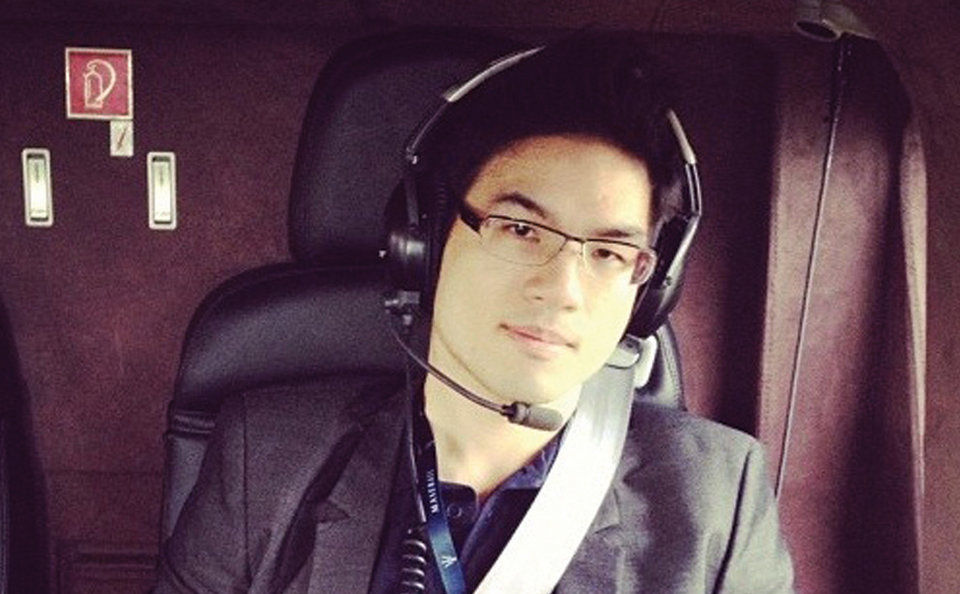
Why do you like sake?
I’ve always loved Japanese food and sake is a big part of that. When I look at the bottle, I love discovering the little heartwarming stories behind each sake brewer.
What differentiates good from bad sake?
Sake is like wine. It all depends on your preferences. But bad sake can be recognized on an immediate level—it will hurt your throat. It shouldn’t be so strong that you can smell the ethanol.
Any bottle you would like to recommend?
Jozen Mizuno Gotoshi. I think it’s very well balanced, a bit sweet, not dry, easy to drink and the aftertaste is a bit fruity.
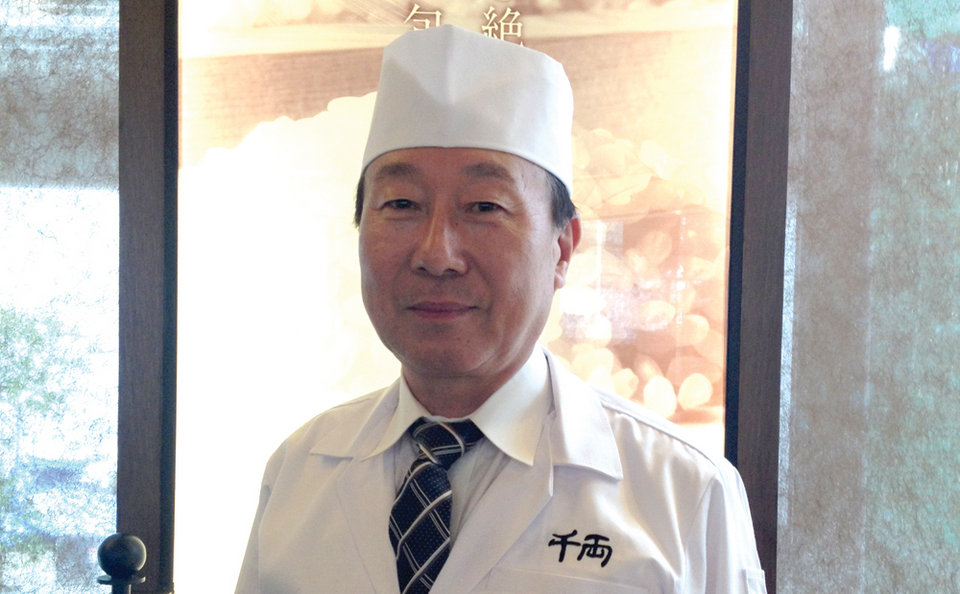
What makes for a good sake?
Every part of the brewing process is important. The rice, for instance, shouldn’t be the same as what you eat at the dining table. It’s important that the brewery uses natural water from nearby sources, too. A cheap sake takes only 14 days to ferment while good ones take around 40-50 days, and they’re best made during winter.
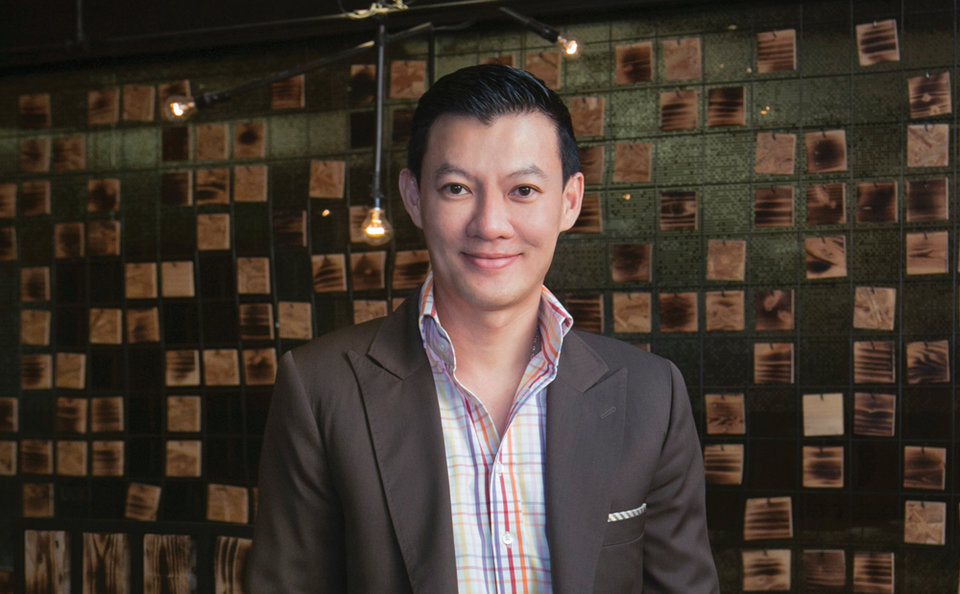
Any bottle you would like to recommend?
President Sake or Hakutsuru Daiginjo. I really love it—fragrant, quite light but with good volume. The aftertaste is amazing, too. But I would advise beginners to start with a very mild sake before moving on to a dry one and then a very dry one.
How do you pair sake with food?
Mainly, meat dishes suit a full-bodied sake, fried dishes go with a flavorful sake like a junmai, while sashimi suits a very light tasting one. Actually, I find sake to be pretty amazing in that it can be paired with any cuisine.
Ogu Ogu
G/F, Park Ventures Ecoplex, 57 Witthayu Rd., 02-108-2255. Open Mon-Thu 11:30am-10pm; Fri-Sun 11:30am-midnight
Sen Ryo
Room RG01, G/F, Nihonmura Mall, 85 Thonglor Soi 13, 081-875-2682 Scheduled to open this month.
Tenyuu
Sathorn Rd. (in front of Soi 8), 02-632-1777. Open Mon-Sun 11:30am-2:30pm, 5:30pm-midnight
O’zake
Thonglor Soi 15, 02-712-7555. Scheduled to open this month.
Advertisement
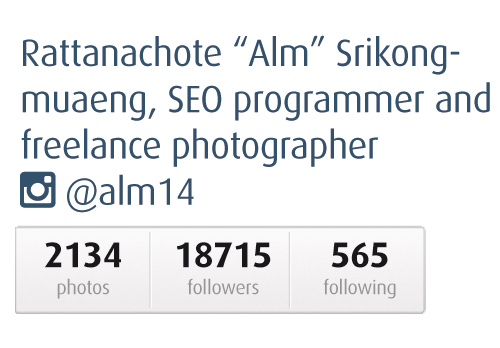 What do you mostly post?
What do you mostly post?My activities and selfies. Instagram is like a relaxing place where I love to share good stuff with people. Posting my six-pack shows that I love my healthy lifestyle without having to explain it in words.
Why are you so popular?
There’s no one reason. My number of followers grew gradually over many months as my friends tagged me in their photos. It’s called viral feeding. They might love my lifestyle. I’m a landscape photographer, so I always post beautiful places and fun activities.
Do you have any stalkers or annoying followers?
I occasionally get some psycho followers who leave dirty comments like, “What’s the size of your dick?” I delete them all. My parents are also on Instagram and follow me. I don’t want them to see those kind of things.
Are you addicted?
I think so. I post about 3-4 pictures a day. I have so many pictures from my work that I simply feel the need to post.
What are the benefits?
I’ve gotten jobs from followers. It’s also great to know I have friends in other countries, as many of my followers live abroad. I’ve been recognized walking around Taipei and Singapre, where I got taken to pubs and restaurants that only locals know! It’s cool. Instagram also brought me back in contact with friends from kindergarten, too!
See his Instagram feed here.
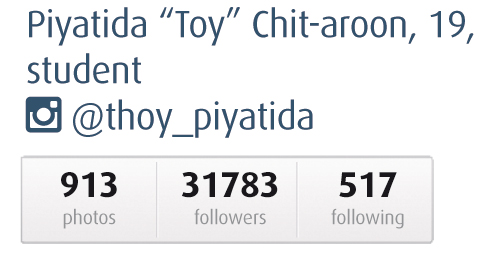 Why are you so popular?
Why are you so popular?
I think it might be down to the fact that I’ve been tagged by my friends and people come to my account to follow me, too. Lots of my friends are DJs and actors.
Do you have any stalkers?
Not really. My followers are nice. But some annoying people try to use my photos as a way to promote their shops or products. Also, some foreigners leave comments like “you’re ugly.” I delete them all, though. I don’t want any strangers saying stuff like that.
Are you addicted?
Yes. I must post at least 1-2 photos a day and I check it every 10 minutes if I don’t have anything to do. I know that it’s not good. Sometimes it means I don’t really interact with the people around me or spend my time on more worthwhile things.
What are the benefits?
I’ve had some modeling jobs before, but Instagram definitely helps me get my name out there. I’ve gotten small roles in lakorn or sitcoms through it. Agencies have also contacted me to advertise their products, such as facial creams and supplements. As I have 30,000-plus followers, I charge B7,000-B10,000 depending on the product.
See her Instagram feed here.
 What do you mostly post?
What do you mostly post?
It’s mostly to do with my job as an MC as well as personal activities like hanging out with friends. Many people have the wrong perception about my line of work thinking that we’re all mistresses of rich men. But showing my lifestyle is a way to tell people the truth about what we do. We are just as serious about our job as those who work in offices. I also share beauty and fashion tips with my fans, too. Some of my pics might be sexy but it’s basically just my portfolio showing that I do various jobs.
Do you have any stalkers?
I normally delete any dirty comments. The most disgusting one was probably a guy who said he wanted to have sex with me. But, honestly, dirty comments are really rare. I normally get good feedback from fans. Sometimes it’s a mid-40s office woman who remembered me from when I worked at the motor show. Sometimes it’s a foreigner who tries to impress me by commenting in Thai with words they’ve got from Google Translate. Those make me laugh.
Are you addicted?
Yes. I post 2-4 pictures a day and constantly check my account. It’s pretty annoying for the people around me.
What are the benefits?
Instagram is like my work portfolio with my lifestyle thrown in. I don’t even have to cast for a job these days. I get money from people who want to sell their products on my Instagram. I charge B4,000-B5,000 per picture. But I don’t take all the offers that come my way because I want the focus to be on my lifestyle and getting people to know me more.
See her Instagram feed here.
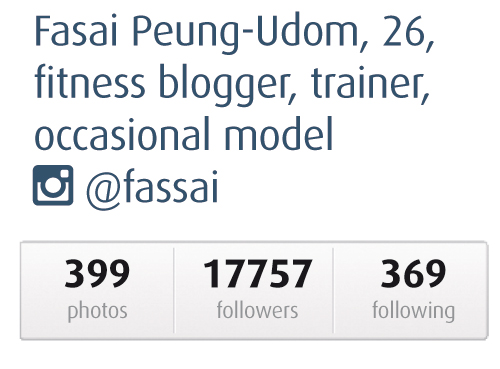 When did you start Instagramming?
When did you start Instagramming?
Just six months ago. I wasn’t a part of Thailand’s smartphone craze as I just got back from New Zealand where people aren’t so addicted to social media.
What do you mostly post?
I actually started it for my model toy business but I realized that it didn’t work because my target customers weren’t on Instagram. So, I switched to selling another product, my fitness routine which I’ve done for years and which I promote by posting selfies. I also post fitness tips such as how to eat well or how to lose weight.
Why are you so popular?
It started when I was doing some modeling and the people started tagging the pics with my Instagram account. I think that when people visited my profile, they noticed that my posts provide useful tips for staying fit and healthy—so they decided to follow me. I mainly use Thai and most of my followers are Thai.
Do you have any stalkers or annoying followers?
Nope. There’s only been the case of an online business stealing my photos to promote their products. But I couldn’t be bothered by that. I do sometimes bump into my followers on the street, though, so I have to make sure I dress well before going out!
Are you addicted?
Totally. I post 2-3 photos a day and constantly plan my posts in advance. I want people to remember me whenever they think about fitness. I see it as my job, so it’s a healthy obsession.
What are the benefits?
It’s good for my credibility, for sure. People are more likely to believe in what I say. It also pushes me to do better. There are many talented people out there, so I need to work hard to stay ahead.
See his Instagram feed here.
 Why are you so popular?
Why are you so popular?
I think it’s because of all the [South Koren entertainer] G-Dragon fans—I’m one too! I did my hairdo like his and it seems one of the GD fans spotted me. After that, my followers list grew very fast, at almost 2,000 new followers a day. But now it’s pretty steady.
Do you have any stalkers?
I do. I had no choice but to block some people who repeatedly commented on all my pictures. Often these are gay haters, mostly men. They leave rude comments after seeing my pictures on Instagram’s “explore” popular page. I have to delete them all the time. My girlfriend is also harassed by some of my followers. They’re just jealous of her.
Are you addicted?
Absolutely, but I’m trying to slow down a bit now. It’s really unhealthy. I used to think about posting photos all the time. It left me no time to just be with myself. I’m too tired to follow others.
What are the benefits?
I’ve now got lots of foreign friends, especially in Asia. I’ve made connections for when I want to travel to places like Indonesia or Vietnam. Some people contact me for advice as their country doesn’t accept gay relationships. Some companies contacted me to sell their products on my Instagram account but I turned most of them down. I don’t want to mess up my posts. I already sell products such as shirts, facial cream and supplement ary milk, so I don't want to confuse my followers about where stand.
See her Instagram feed here.

 Why are you so popular?
Why are you so popular?
Gun: We already had lots of followers, but it’s grown really fast as more girls discover we are a gay couple. We call this kind of fan “Y-Girl.” They love to see guys in love with each other. It’s been a trend for a while; they love to imagine their beloved good-looking male singer in love with another guy who is his close friend. They follow us because we are a real-life couple. Also some celebrities like Ploy Chermal have posted our pictures on their accounts—that got us at least 40,000 followers.
Do you have any stalkers?
Gun: As our pictures always pop up on Instagram’s “explore” page, there are many foreigners who leave rude comments like “Fuck Gays,” “Fuck your mother,” or “Shit”—our fans fight back, too, though.
Are you addicted?
Theo: Kind of, but I don’t think it’s too much. We just post photos when we go out to work or to cool places, or if we just want to say hi to our fans. At most, it’s about 3-4 photos a day. Some days we don’t post anything.
Gun: I don’t think I’m addicted. It’s normal to post photos on social networks.
What are the benefits?
Theo: Fans! We get more people who love us and care about us. Our fans range from teenagers to 50-year-old aunties. Of course, we also get more jobs out of it. We’ve been hired to go out and post about events and products. We also have two movie projects coming out. One is due in June, TomGay: Muen Rak Salub Kua, and another, Boy Story, might be out in July.
Advertisement
Codeacademy.com
Don’t have any programming knowledge? Get some from this really intuitive (and free) online school.
Delivering Happiness by Tony Hsieh
Required reading at the RedMart office, it really demonstrates the importance of delivering a ‘wow’ experience to your customers.
Outgrow.me
This is the first online marketplace for inventions that have been successfully funded via Kickstarter or Indiegogo—a great way to check if someone’s already monetized your “great idea”.
The Social Network
The blockbuster starring Jesse Eisenberg and Justin Timberlake offers entertaining insight into the makings of a billion dollar startup, which in this case is Facebook.
Thelist.sg
Run by SGEntrepreneurs writer Kristine Lauria (krissymo.com), this is an immensely useful online calendar of events in Singapore, mostly free and tech startup related.
Advertisement
Asana
Used by the teams at Dropbox, Pinterest and Uber, this virtual shared task list (available on Android, iTunes and the web) cuts down management time by allowing you to set and view assignments by project and team member.
Github
A collaboration and management tool that’s specifically designed for coding projects.
Hootsuite
Luxola uses the friendly Hootsuite interface to schedule posts on Facebook and Twitter, and analyze response.
Line
The startup community’s gone way beyond Whatsapp and for good reason. Line (available on Android, iTunes and on the web) is a messaging service developed in Japan that features free voice calls and interactive stickers.
Advertisement
I’m a walking contradiction with 365 personalities. The people around me have to be so patient.
I’m insecure about my looks. I was told to my face that I wasn’t good looking enough to be an actor when I tried out for a small role. It completely destroyed my confidence. Even to this day, I can’t bear to look at myself brushing my teeth.
The confident Woody is just a shield. Everyone says I’m such a big success, but I still think of myself as Woody the fat kid I was ten years ago. I have an inferiority complex.
Shopping in the supermarket is my favorite moment to be myself. It’s all about choosing what you want without anyone else interfering.
Thais are afraid to be different and prefer to stick together in groups. That’s why we have kids who don’t want to raise their hands – they don’t want to be the black sheep. I came into this industry as someone different and people judged me as over-the-top.
Everything on TV is acting, even reading the news. I dreamed of being an actor since I was very young, so I’ve adjusted my skills to all my TV duties.
I was actually born to listen. Even though my show is named “Born to Talk,” it’s me being a good listener that makes the show more appealing.
I’m not a frank person. I’m so Thai. I say never mind when I do mind. I’m shy, I compromise and I lie.
I’ve struggled, too. People think that I used my connections to get where I am today. But I’ve done it all by myself. I proposed the show myself. I had only a few hundred baht left in my bank account and had to ask for a loan to pay my employees. They needed to feed their families. I don’t sit and wait for people to give me a chance.
I’m a big risk taker. I love to push myself as far as possible. It will be satisfying to see how far I can go before I die.
Showing the bright and the dark sides of this world is my favorite thing as a host. Not everyone gets to meet the most creative people, the greatest liars or swindlers in person, but I can show these people and let the audience decide what or who is good or bad.
Critics are a part of our life. I’m always aware that my character will be criticized. I just take it as a lesson in understanding what’s acceptable in Thai society.
People hate to see bad guys on TV. I learned this when I interviewed Yo (Yossawadee Hassadeevichit) who was accused of having an affair with another woman’s husband. People were mad at me and said I supported this behavior by interviewing her. People even called for the end of my show and insulted my parents. I was so depressed and thought of quitting the industry.
Forgetfulness is both a good and a bad quality of Thais. As time passes, Thai people really don’t give a shit about what you’ve done because they have more important things to concentrate on. Anyway, I have to thank all the critics. If it weren’t for them, I would have missed out on many important lessons.
I regret passing on the chance to interview Justin Bieber three years ago. I gave the opportunity to Chris Horwang while I went and did another job instead. He is so huge today. It would be great to meet him.
I don’t believe in marriage. Whether you’re straight or gay, you don’t need a stamp of approval to say that you’re a couple. A union happens through trust and love, not a piece of paper. I don’t pain on getting married.
I don’t see myself becoming a family man. I just want to travel around the world with the one I love. I plan to go to every single country in the world.
Japan is my favorite place nowadays. I used to think the US was the best, with New York, Los Angeles and Miami, but Tokyo is even better. Their social values, creativity, quietness and gentleness are refreshing. Railway officers will even come to bow and apologize if you’re going through the wrong turnstile. Where else in the world does that happen? Sometimes I even feel like I’m Japanese but born in Thailand.
I see myself as Asian, not Thai. People will probably hate me for saying that. But we live in a region comprising many different cultures. It’s our Asia. In the future, people will proudly say, “I’m Asian.” Anyway, I still cherish the Thai kindness that makes Thailand the most livable country in the world.
I decided to launch the Big Event company because I want to usher in a new wave of creativity in Thailand, not just be another events marketing business. The new generation knows that creativity is what will drive ASEAN and Asia in the future.
Alexander the Great is the person I want to interview most. I want to know what ran through the mind of the young commander who led hundreds of thousands of troops to conquer half the world. I also want to interview King Rama V. I want to follow him around Europe and be there when he made the royal command of the Emancipation Proclamation.
I want to be a movie maker. I’ve been writing a script for 10 years and it will see the light of day in the next few years. It will show a soft and funny side of me that people have never seen.
I’ll be a host until I die. My last question might be, “Who did you have sex with last night?” and then I’ll die in my chair.
Advertisement